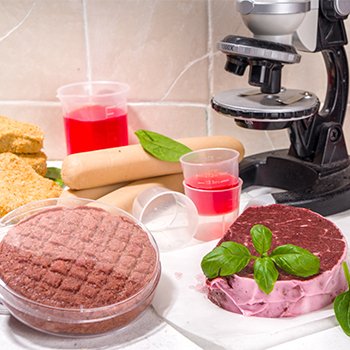อาหารเพาะเลี้ยงจากเซลล์: อนาคตที่สดใสของแหล่งโปรตีนที่มั่นคงและยั่งยืน Cell-based Foods: The Promising Future of Security and Sustainability Protein Source
99 Views |

อาหารเพาะเลี้ยงจากเซลล์: อนาคตที่สดใสของแหล่งโปรตีนที่มั่นคงและยั่งยืน
Cell-based Foods: The Promising Future of Security and Sustainability Protein Source
By: Merdient Co., Ltd.
อาหารเพาะเลี้ยงจากเซลล์คืออะไร
อาหารเพาะเลี้ยงจากเซลล์ผลิตขึ้นจากการคัดแยกเซลล์จากสัตว์ พืช หรือจุลินทรีย์ แล้วนำมาเพาะเลี้ยงในอาหารเลี้ยงเชื้อที่มีสารอาหารสูง ซึ่งเป็นการเลียนแบบการเจริญตามธรรมชาติของเนื้อเยื่อ จึงทำให้สามารถผลิตเนื้อสัตว์ สัตว์ปีก อาหารทะเล ผลิตภัณฑ์นม และไข่ได้ โดยไม่จำเป็นต้องเลี้ยงและฆ่าสัตว์ รวมถึงได้ผลลัพธ์เป็นผลิตภัณฑ์ที่เหมือนกับเนื้อสัตว์ทุกประการ แต่มีผลกระทบต่อสิ่งแวดล้อมลดลง
วิทยาศาสตร์เบื้องหลังอาหารเพาะเลี้ยงจากเซลล์
กระบวนการผลิตอาหารเพาะเลี้ยงเริ่มต้นด้วยการคัดเลือกเซลล์ที่มีคุณภาพสูงจากสัตว์ต้นกำเนิด จากนั้นจะนำเซลล์เหล่านี้ไปวางไว้ในถังเพาะเลี้ยง (Bioreactor) ซึ่งเซลล์จะได้รับสารอาหารที่จำเป็นต่อการเจริญเติบโต ภายใต้สภาพแวดล้อมที่เหมาะสำหรับการเพิ่มจำนวนและการแบ่งตัวเพื่อสร้างเป็นเนื้อเยื่อที่ต้องการ โดยเซลล์เหล่านี้จะก่อร่างและสร้างเส้นใยกล้ามเนื้อ ไขมัน และส่วนประกอบอื่นๆ ที่ประกอบขึ้นมาให้คล้ายกับเนื้อสัตว์
ข้อได้เปรียบที่สำคัญประการหนึ่งของการเพาะเลี้ยงอาหารจากเซลล์ คือ ประสิทธิภาพการผลิต เมื่อเปรียบเทียบกับการทำปศุสัตว์แบบดั้งเดิมที่ต้องใช้พื้นที่ น้ำ และอาหารสัตว์เป็นจำนวนมาก อีกทั้งยังก่อให้เกิดก๊าซเรือนกระจกสูง ตรงข้ามกับการผลิตอาหารเพาะเลี้ยงจากเซลล์ที่ใช้ทรัพยากรน้อยกว่า และก่อให้เกิดขยะหรือมลพิษน้อยลง ดังนั้น อาหารเพาะเลี้ยงจากเซลล์จึงนับเป็นทางเลือกที่ยั่งยืนกว่าการเลี้ยงสัตว์ในปัจจุบัน
ประโยชน์ของอาหารเพาะเลี้ยงจากเซลล์
1. ผลกระทบต่อสิ่งแวดล้อม: อาหารเพาะเลี้ยงจากเซลล์มีศักยภาพในการลดผลกระทบต่อสิ่งแวดล้อมจากการผลิตอาหารได้ เนื่องจากไม่จำเป็นต้องทำการปศุสัตว์ขนาดใหญ่อีกต่อไป จึงสามารถอนุรักษ์ทรัพยากรธรรมชาติ และลดการปล่อยก๊าซเรือนกระจก
2. สวัสดิภาพสัตว์: การพิจารณาทางด้านจริยธรรมถือเป็นปัจจัยสำคัญที่ช่วยสนับสนุนให้มีการผลิตอาหารเพาะเลี้ยงจากเซลล์ เนื่องจากเป็นเทคโนโลยีที่ไม่จำเป็นต้องฆ่าสัตว์ จึงเป็นทางเลือกที่ปราศจากการทารุณกรรมสัตว์แทนการผลิตเนื้อสัตว์แบบดั้งเดิม
3. ความมั่นคงทางอาหาร: เนื่องด้วยจำนวนประชากรโลกที่เพิ่มขึ้นอย่างต่อเนื่อง การสร้างความมั่นคงและความปลอดภัยทางอาหารจึงมีความสำคัญมากขึ้น ซึ่งอาหารเพาะเลี้ยงจากเซลล์ที่ผลิตได้ในสภาพแวดล้อมควบคุมนั้นจะช่วยลดความเสี่ยงของการเกิดโรคที่มาจากอาหารและการหยุดชะงักตลอดห่วงโซ่อุปทานได้
4. คุณค่าทางโภชนาการ: อาหารเพาะเลี้ยงจากเซลล์สามารถออกแบบให้มีคุณค่าทางโภชนาการในรูปแบบเฉพาะเพื่อเพิ่มทางเลือกที่มีประโยชน์ต่อผู้บริโภค อาทิ การพัฒนาผลิตภัณฑ์ให้มีไขมันที่ดีต่อสุขภาพ เช่น กรดไขมันโอเมก้า 3 เป็นต้น
What is Cell-based Foods?
Cell-based foods are produced by isolating cells from animals, plants, or microorganisms and growing them in a nutrient-rich medium. This process mimics the natural growth of tissues, allowing for the production of meat, poultry, seafood, dairy, and even eggs without the need to raise and slaughter animals. The result is a product that is molecularly identical to conventional meat but with a significantly reduced environmental footprint.
The Science Behind Cell-based Foods
The production of cell-based foods begins with selecting high-quality cells from a donor animal. These cells are then placed in a bioreactor, where they are provided with the necessary nutrients for growth under suitable environmental conditions to proliferate and differentiate into the desired tissue. Over time, these cells form muscle fibers, fat, and other components that make up meat.
One of the key advantages of this method is its efficiency compared to traditional livestock farming, which requires vast amounts of land, water, and feed. This traditional method also generates significant greenhouse gas emissions. In contrast, cell-based food production uses fewer resources and produces less waste, making it a more sustainable option.
Advantages of Cell-based Foods
1. Environmental Impact: Cell-based foods have the potential to drastically reduce the environmental impact of food production. By eliminating the need for large-scale animal farming, which can help conserve natural resources and reduce greenhouse gas emissions.
2. Animal Welfare: One of the most compelling arguments for cell-based foods is the ethical consideration. Since these products do not require the slaughter of animals, they offer a cruelty-free alternative to traditional meat.
3. Food Security: As the global population continues to grow, ensuring food security and safety becomes increasingly important. Cell-based foods can be produced in controlled environments, reducing the risk of foodborne and supply chain disruptions.





